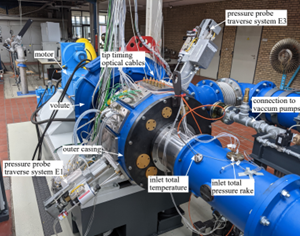DARLING — Damaged and Repaired Blade Modeling with in-situ Experiments
The project focuses on aerodynamic and aeromechanical evaluation and detection of degraded and damaged fan- and compressor blades, as well as repair actions, in modern aero engines. The project is coordinated by GKN Aerospace AB and continues an established collaboration between GKN, KTH and Stuttgart University, Germany. The collaboration with Stuttgart University allows Swedish partners access to advanced European experimental infrastructure in aerospace engineering which does not exist in Sweden.
Background
Long-term operation of aircraft engines and unfavorable operating conditions can degrade the aerodynamic performance of fan and compressor components over time, leading to increased fuel consumption and a higher environmental impact. This deterioration can also result in higher maintenance costs and accessibility challenges that affect users. A primary cause of reduced performance is the degradation of blade leading-edge geometry due to erosion and mechanical damage from foreign objects entering the engine. This is particularly critical for vanes operating at transonic flow speeds, where previous research has shown that aerodynamic performance is highly sensitive to changes in leading-edge geometry. However, there is limited understanding of how such damage affects the aeromechanical properties of blades and whether it increases the risk of unforeseen blade vibrations. Addressing this question is one of the core aims of the proposed project.
Improving diagnostics through sensors and advanced algorithms could enhance material utilization and engine availability by reducing the need for visual inspections - especially when limited access would otherwise require engine disassembly. Repairing aero engine components is also crucial for sustainability, as it can help recover lost performance due to degradation and damage, potentially avoiding the need to replace blades or entire blisks.
Aim and objectives
In this project, several compressor blisks will be manufactured and evaluated both analytically and experimentally, using the transonic compressor rig at the University of Stuttgart. Testing will include both the nominal geometry and geometries representing in-service wear, as well as repaired states. Experimental data, supported by virtual models and calculations, will be used to develop an advanced model for categorizing and quantifying blade damage in engines based on measurements. This model will enable the detection of any damage on the blisk, including its location and severity.

Project partners
-
GKN AEROSPACE SWEDEN AB, Sweden
-
KTH Royal Institute of Technology, Sweden
-
ITSM, University of Stuttgart, Germany
Funding is provided by Vinnova (NFFP8 program, 2nd call)
Timeframe: 11 June 2024 – 14 June 2028
Researchers
Publications
Publications coming out of this project will be available through Diva
